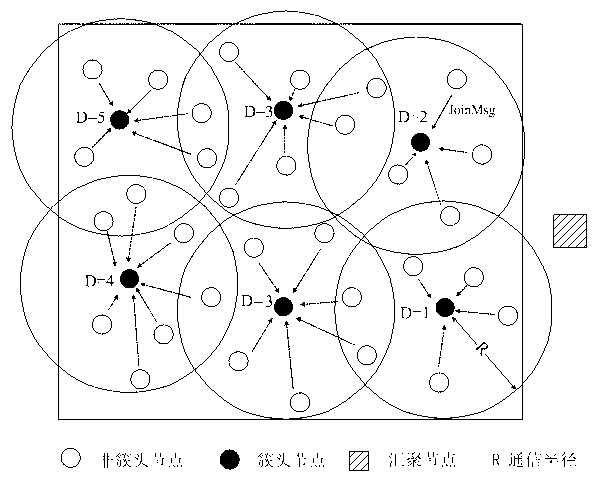Wireless sensor network cluster routing protocol based on node depth
A wireless sensor and node depth technology, applied in wireless network protocols, network topology, wireless communication, etc., can solve the problems of unbalanced energy consumption of nodes, high energy consumption of single-hop transmission of cluster head data, etc.
- Summary
- Abstract
- Description
- Claims
- Application Information
AI Technical Summary
Problems solved by technology
Method used
Image
Examples
Embodiment Construction
[0036] Below in conjunction with accompanying drawing, the present invention is described in further detail;
[0037] The CRAND protocol first establishes the depth of nodes in the network. The node depth value plays an important role in the stage of cluster formation and inter-cluster routing selection. The node adopts the node depth generation method based on the number of hops, and all nodes determine their own node depth according to the received node depth message.
[0038] 1 Initialization phase
[0039] When the wireless sensor network is initialized, the node depth value Depth of the sink node is set to 0, and the node depth values of other nodes are initially set to infinity. The Sink node broadcasts a DepthSet packet with a communication radius R, including three parameters: DataType, NodeID and Depth, where Depth=MyDepth+1. After other nodes receive the broadcast information, use the following method to process it;
[0040] When a node receives the DepthSe...
PUM
 Login to View More
Login to View More Abstract
Description
Claims
Application Information
 Login to View More
Login to View More - R&D
- Intellectual Property
- Life Sciences
- Materials
- Tech Scout
- Unparalleled Data Quality
- Higher Quality Content
- 60% Fewer Hallucinations
Browse by: Latest US Patents, China's latest patents, Technical Efficacy Thesaurus, Application Domain, Technology Topic, Popular Technical Reports.
© 2025 PatSnap. All rights reserved.Legal|Privacy policy|Modern Slavery Act Transparency Statement|Sitemap|About US| Contact US: help@patsnap.com



